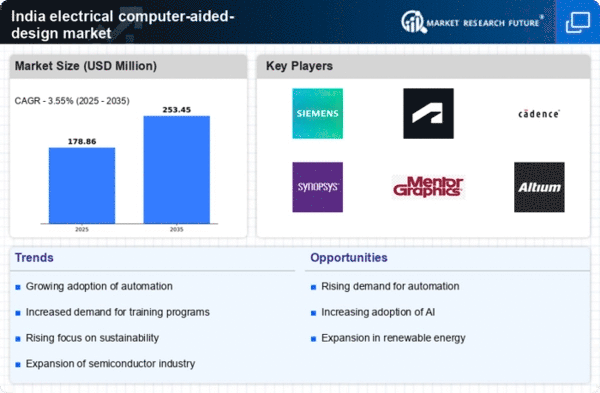Growing Emphasis on Skill Development
The electrical computer-aided-design market in India is witnessing a growing emphasis on skill development among professionals. As the industry evolves, there is a pressing need for skilled personnel who can effectively utilize advanced CAD tools. Educational institutions and training centers are increasingly offering specialized courses in electrical design software, which is likely to enhance the talent pool in the market. This focus on skill development is crucial, as it ensures that the workforce is equipped to meet the demands of modern design challenges. Moreover, companies are investing in training programs to upskill their employees, which may lead to improved productivity and innovation within the electrical computer-aided-design market.
Rising Demand for Automation in Design
The electrical computer-aided-design market in India is experiencing a notable surge in demand for automation solutions. As industries increasingly seek to enhance productivity and reduce human error, the adoption of automated design tools is becoming prevalent. This trend is particularly evident in sectors such as manufacturing and construction, where efficiency is paramount. According to recent data, the automation segment within the electrical computer-aided-design market is projected to grow at a CAGR of approximately 15% over the next five years. This growth is driven by the need for faster design cycles and improved accuracy, which automation can provide. Consequently, companies are investing in advanced software that integrates automation features, thereby transforming traditional design processes and fostering innovation across various sectors.
Increased Investment in Research and Development
Investment in research and development (R&D) is a critical driver for the electrical computer-aided-design market in India. Companies are recognizing the importance of innovation in maintaining a competitive edge, leading to increased R&D expenditures. This investment is directed towards developing new features and functionalities in CAD software, which can enhance user experience and design capabilities. Furthermore, collaboration with academic institutions for R&D initiatives is becoming more common, fostering a culture of innovation. As a result, the electrical computer-aided-design market is likely to see the introduction of cutting-edge technologies, which could potentially reshape design processes and improve overall efficiency.
Expansion of the Construction and Manufacturing Sectors
The expansion of the construction and manufacturing sectors in India is significantly influencing the electrical computer-aided-design market. With the government's push for infrastructure development and the rise of smart manufacturing, there is an increasing need for sophisticated design solutions. The construction sector, in particular, is projected to grow at a rate of 10% annually, driving demand for electrical design tools that can accommodate complex projects. This growth is likely to create new opportunities for CAD software providers, as companies seek to streamline their design processes and improve project outcomes. Consequently, the electrical computer-aided-design market is poised for substantial growth, fueled by the ongoing expansion of these key industries.
Government Initiatives Supporting Digital Transformation
The Indian government is actively promoting digital transformation across various sectors, which significantly impacts the electrical computer-aided-design market. Initiatives such as 'Make in India' and 'Digital India' aim to enhance the adoption of advanced technologies, including CAD software. These programs encourage local manufacturers to invest in modern design tools, thereby boosting the market's growth. Furthermore, the government's focus on infrastructure development is likely to increase the demand for electrical design solutions, as new projects require sophisticated design capabilities. As a result, the electrical computer-aided-design market is expected to benefit from increased public and private sector investments, potentially leading to a market growth rate of around 12% in the coming years.

















Leave a Comment